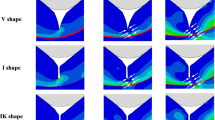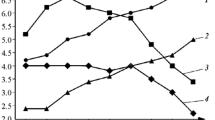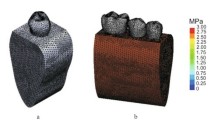Abstract
Finite element analysis is conducted on a tooth model with different degrees of wear. The model is taken as a hemispherical shell (enamel) on a compliant interior (dentin). Occlusal loading is simulated by contact with a flat or curved, hard or soft, indenter. Stress redistributions indicate that development of a wear facet may enhance some near-contact fracture modes (cone–ring cracks, radial–median cracks, edge-chipping), but have little effect on far-field modes (margin cracks). Contacts on worn surfaces with small, hard food objects are likely to be most deleterious, generating local stress concentrations and thereby accelerating the wear process. More typical contacts with larger-scale soft foods are unlikely to have such adverse effects. Implications concerning dietary habits of animals is an adjunct consideration in this work.





Similar content being viewed by others
References
Osborn JW. In: Osborn JW, editor. Dental anatomy and embryology, Vol. 1. Oxford: Blackwell; 1981.
Maas MC, Dumont ER. Built to last: the structure, function, and evolution of primate dental enamel. Evol Anthrop. 1999;8:133–52.
Lucas PW. Dental functional morphology: how teeth work. Cambridge, UK: Cambridge University Press; 2004.
Xu HHK, Smith DT, Jahanmir S, Romberg E, Kelly JR, Thompson VP. Indentation damage and mechanical properties of human enamel and dentin. J Dent Res. 1998;77:472–80.
Lucas PW, Constantino PJ, Wood BA, Lawn BR. Dental enamel as a dietary indicator in mammals. BioEssays. 2008;30:374–85.
Lawn BR, Lee JJ-W, Constantino PJ, Lucas PW. Predicting failure in mammalian enamel. J Mech Behav Biomed Mat. 2009;2:33–42.
Lawn BR, Lee JJ-W. Analysis of fracture and deformation modes in teeth subjected to occlusal loading. Acta Biomater. 2009;5:2213–21.
Teaford MF, Ungar PS. Diet and the evolution of the earliest human ancestors. Proc Natl Acad Sci. 2000;97:13506–11.
Janis CM, Fortelius M. On the means whereby mammals achieve increased functional durability of their dentitions, with special reference to limiting factors. Biol Rev Cambridge Philos Soc. 1988;63:197–230.
Lawn BR, Deng Y, Thompson VP. Use of contact testing in the characterization and design of all-ceramic crown-like layer structures: a review. J Prosthet Dent. 2001;86:495–510.
Lawn BR, Bhowmick S, Bush MB, Qasim T, Rekow ED, Zhang Y. Failure modes in ceramics-based layer structures: a basis for materials design of dental crowns. J Am Ceram Soc. 2007;90:1671–83.
Lee JJ-W, Kwon J-Y, Chai H, Lucas PW, Thompson VP, Lawn BR. Fracture modes in human teeth. J Dent Res. 2009;88:224–8.
Qasim T, Bush MB, Hu X, Lawn BR. Contact damage in brittle coating layers: influence of surface curvature. J Biomed Mater Res. 2005;73B:179.
Qasim T, Ford C, Bush MB, Hu X, Malament KA, Lawn BR. Margin failures in brittle dome structures: relevance to failure of dental crowns. J Biomed Mater Res. 2007;80B:78–85.
Kim J-W, Bhowmick S, Chai H, Lawn BR. Role of substrate material in failure of crown-like layer structures. J Biomed Mater Res. 2007;81B:305–11.
Popowics TE, Rensberger JM, Herring SW. The fracture behavior of human and pig molar cusps. Arch Oral Biol. 2001;46:1–12.
Chai H, Lawn BR, Wuttiphan S. Fracture modes in brittle coatings with large interlayer modulus mismatch. J Mater Res. 1999;14:3805–17.
Chai H, Lawn BR. A universal relation for edge chipping from sharp contacts in brittle materials and its use as a simple means of toughness evaluation. Acta Mater. 2007;55:2555–61.
Qasim T, Bush MB, Hu X-Z. The influence of complex surface geometry on contact damage in curved brittle coatings. Int J Mech Sci. 2006;48:244–8.
Cuy JL, Mann AB, Livi KJ, Teaford MF, Weihs TP. Nanoindentation mapping of the mechanical properties of molar enamel. Arch Oral Biol. 2002;47:281–91.
Chai H, Lee JJ-W, Constantino PJ, Lucas PW, Lawn BR. Remarkable resilience of teeth. Proc Natl Acad Sci. 2009;106:7289–93.
Ford C, Bush MB, Hu XZ. A numerical study of contact damage in curved porcelain/glass-filled polymer bilayers. Compos Sci Technol. 2004;64:2207–12.
Qasim T, Ford C, Bush MB, Hu X, Lawn BR. Effect of off-axis concentrated loading on failure of curved brittle layer structures. J Biomed Mater Res. 2006;76B:334.
Quinn JB, Su L, Flanders L, Lloyd IK. Edge toughness and material properties related to the machining of dental ceramics. Mach Sci Tech. 2000;4:291–304.
Chai H, Lawn BR. Edge chipping of brittle materials: effect of side-wall inclination and loading angle. Int J Fract. 2007;145:159–65.
Spears IR. A three-dimensional finite element model of prismatic enamel: a reappraisal of the data on the Young’s modulus of enamel. J Dent Res. 1997;76:1690–97.
Sognnaes RF. The organic elements of enamel. II. The organic framework of the internal part of the enamel, with special regard to the organic basis for the so-called tufts and Schreger bands. J Dent Res. 1949;28:549–57.
Osborn JW. The 3-dimensional morphology of the tufts in human enamel. Acta Anat. 1969;73:481–95.
Acknowledgments
This work was supported by a grant from the Australian Research Council.
Author information
Authors and Affiliations
Corresponding author
Rights and permissions
About this article
Cite this article
Ford, C., Bush, M.B. & Lawn, B. Effect of wear on stress distributions and potential fracture in teeth. J Mater Sci: Mater Med 20, 2243–2247 (2009). https://doi.org/10.1007/s10856-009-3802-5
Received:
Accepted:
Published:
Issue Date:
DOI: https://doi.org/10.1007/s10856-009-3802-5




